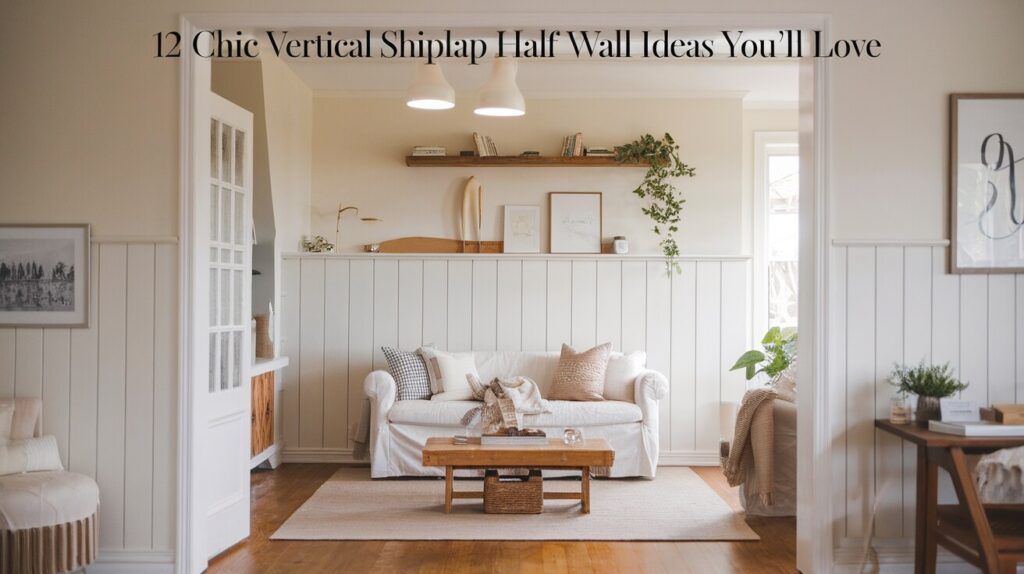Vertical shiplap half walls add character and dimension to homes without overwhelming a space. Unlike full walls that extend to the ceiling, half walls create visual interest while keeping rooms open. Vertical boards, running from floor to halfway up, offer a different look than the traditional horizontal arrangement, creating an illusion of height.
These partial walls have gained favor in both modern and traditional homes for good reason. They’re practical and stylish without being complicated to install.
In this article, you’ll find 12 inspiring ideas for adding vertical shiplap half walls to your home. We’ll cover the best places to use them, color options that work, and simple ways to style them for maximum impact.
As renovation specialists with years of experience, we understand the challenges of finding design elements that are both functional and beautiful. These ideas will help you transform ordinary walls into striking focal points.
Benefits of a Vertical Shiplap Half Wall
When I renovated my home, vertical shiplap half walls solved several problems at once. You’ll appreciate how they create an illusion of height in rooms with low ceilings-those upward lines naturally draw your eyes up.
Need to break up a blank wall? These partial walls add character without closing in your space.
I love their budget-friendly appeal. Materials are affordable, and if you’re handy with basic tools, you can install them yourself over a weekend. My dining room project cost less than $200.
Durability matters in busy homes. These walls resist scuffs and bumps in:
- Entryways where backpacks get dropped
- Dining areas facing daily spills
- Hallways with heavy foot traffic
- Playrooms needing extra protection
They’re easy to clean with just a damp cloth, and their vertical orientation adds a fresh twist to the classic shiplap look.
12 Chic Vertical Shiplap Half Wall Ideas (Elaborated)
1. Classic White with Sleek Trim

The timeless appeal of white vertical shiplap creates an instantly bright and clean aesthetic in any room. I’ve installed this in several homes and find it works as a perfect canvas for other design elements to shine. The white color reflects natural light, making even smaller rooms feel more spacious and open.
What makes this style work so well is its versatility. The crisp white boards provide texture without competing with other design elements. The vertical orientation draws the eye upward, creating an illusion of higher ceilings, particularly beneficial in homes with standard 8-foot heights.
How to incorporate it effectively:
- Choose a pure white semi-gloss or satin paint for easy cleaning and slight light reflection
- Install boards approximately 36-48 inches high from the floor
- Cap with simple 2-3 inch trim in matching white
- For an authentic shiplap look, leave a 1/8 inch gap between boards
- Use in spaces like dining rooms, living areas, or hallways
- Pair with colorful art, textiles, or furniture that will stand out against the neutral backdrop
- Add warmth with wood tones in furniture or accents to balance the crispness
2. Bold Black or Navy for Contrast
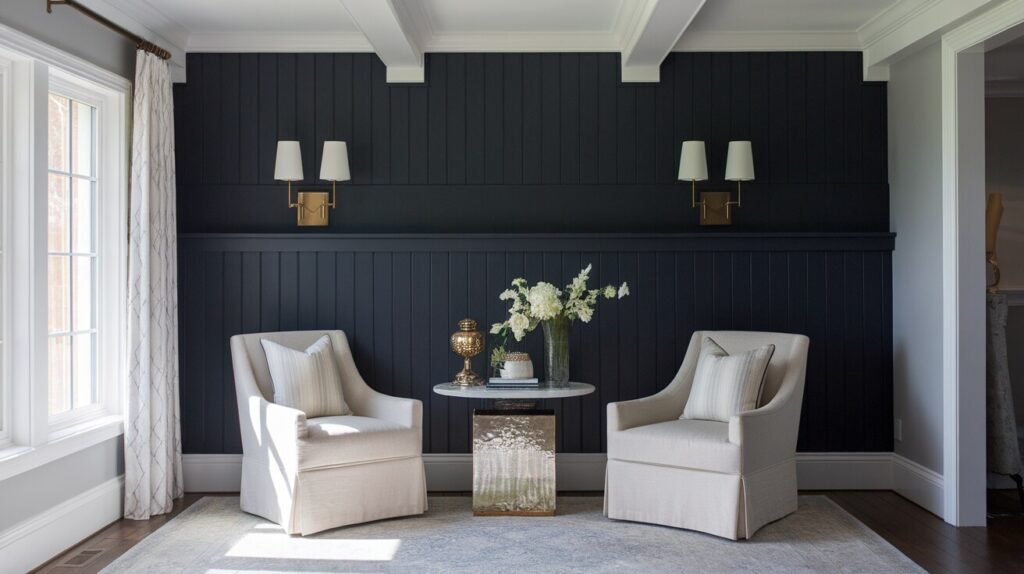
Dark-colored vertical shiplap creates a dramatic focal point that immediately draws attention. When I painted my dining room’s half wall navy blue, it transformed the space from ordinary to sophisticated. The deep color adds richness and depth while the vertical lines maintain a modern edge.
The key to making dark shiplap work is balance. The contrast between dark walls and light furnishings creates visual interest and prevents the space from feeling too heavy or closed in. The vertical lines in these dark colors create a striking architectural feature that feels intentional and designer-quality.
How to incorporate it effectively:
- Select high-quality paint in matte or eggshell finish to reduce light reflection and enhance the rich color
- Test samples in your actual space to see how the lighting affects the color throughout the day
- Install in rooms with adequate natural light to prevent the space from feeling too dark
- Balance with light-colored furniture, rugs, and accessories
- Add mirrors or metallic accents to reflect light and brighten the space
- Consider using in dining rooms, studies, or bedrooms where a more intimate atmosphere is appropriate
- Pair with crisp white trim for sharp definition and contrast
3. Monochrome Minimalism
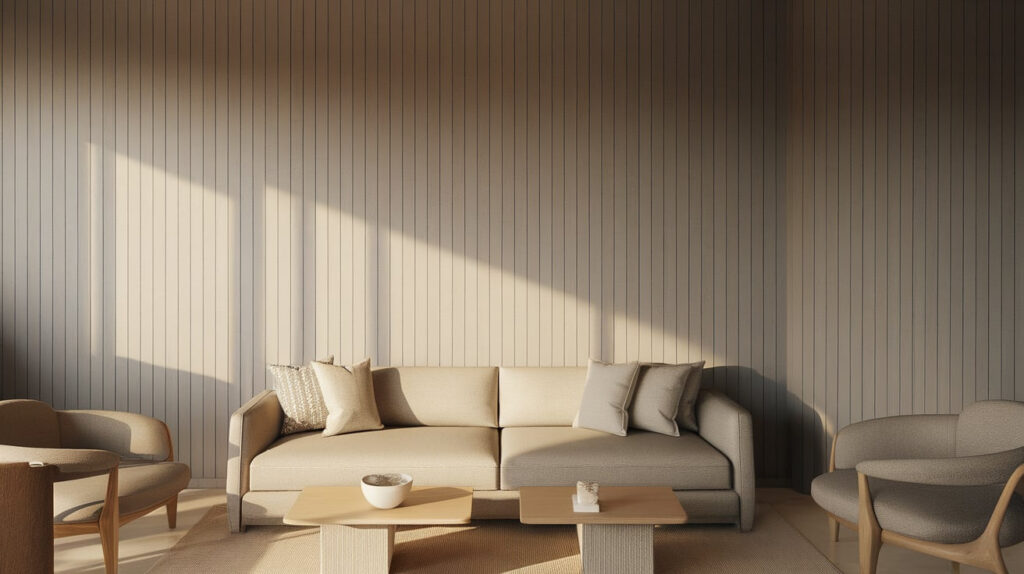
For a subtle, contemporary look, painting your vertical shiplap the same color as the surrounding walls creates sophisticated texture without visual interruption. This approach adds architectural interest through shadow and texture rather than color contrast.
I’ve used this technique in modern homes where clients wanted visual interest without bold statements. The effect is particularly striking in all-gray or all-white schemes, where the changing light throughout the day creates shifting shadows across the textured surface.
How to incorporate it effectively:
- Use the same paint color for both walls and shiplap
- Create subtle contrast by using different finishes-matte for walls and satin for shiplap
- Keep the half wall height consistent with other architectural details in the room
- This style works particularly well in minimalist spaces, home offices, or modern living rooms
- Add depth with varied textures in furnishings-smooth leather, nubby linen, or plush velvet
- Consider installing in spaces where you want texture without drawing too much attention
- Use warm-toned lighting to enhance the subtle shadows created by the boards
4. Natural Wood Finish
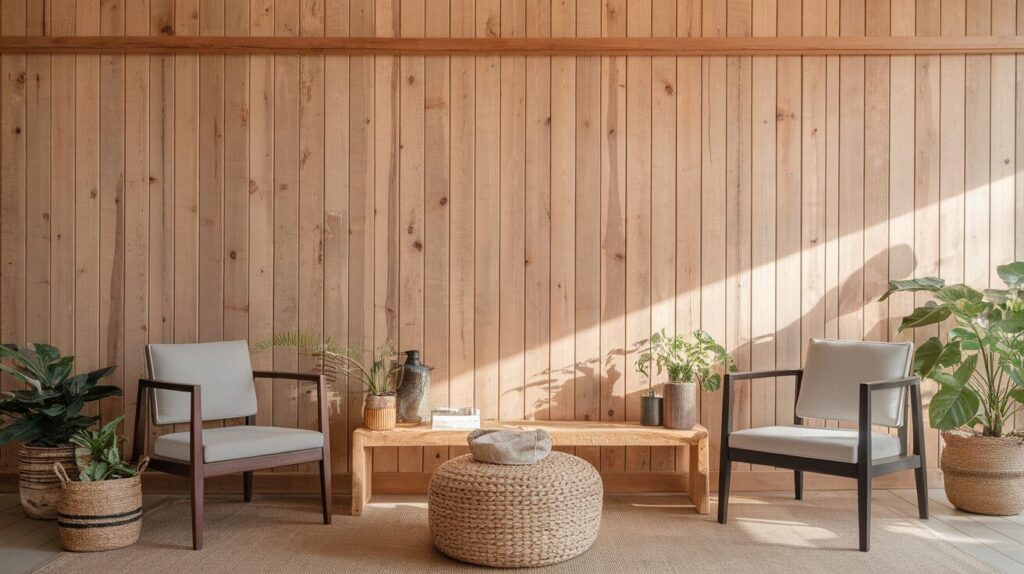
Clear-sealed wood shiplap celebrates the inherent beauty of natural materials. The grain patterns, knots, and color variations create visual interest that synthetic materials can’t match. The warmth of wood adds an organic element that feels both timeless and contemporary.
I left the pine shiplap in my son’s room with only a clear sealant, and five years later, it has developed a beautiful patina that adds character to the space. The vertical orientation modernizes what could otherwise feel like a traditional cabin aesthetic.
How to incorporate it effectively:
- Select boards with interesting grain patterns-pine, oak, cedar, or walnut all work well
- Apply 2-3 coats of clear polyurethane to protect the wood while showing its natural beauty
- Consider using boards with varying tones for added depth and interest
- Install in kitchens, dining spaces, or family rooms where warmth is welcome
- Pair with plants and natural textiles to enhance the organic feel
- Mix with painted furniture pieces for contrast
- For Scandinavian style, use light pine or birch; for richer looks, consider walnut or oak
- Maintained with occasional light sanding and resealing every few years
5. Vintage Cottagecore with Distressed Wood
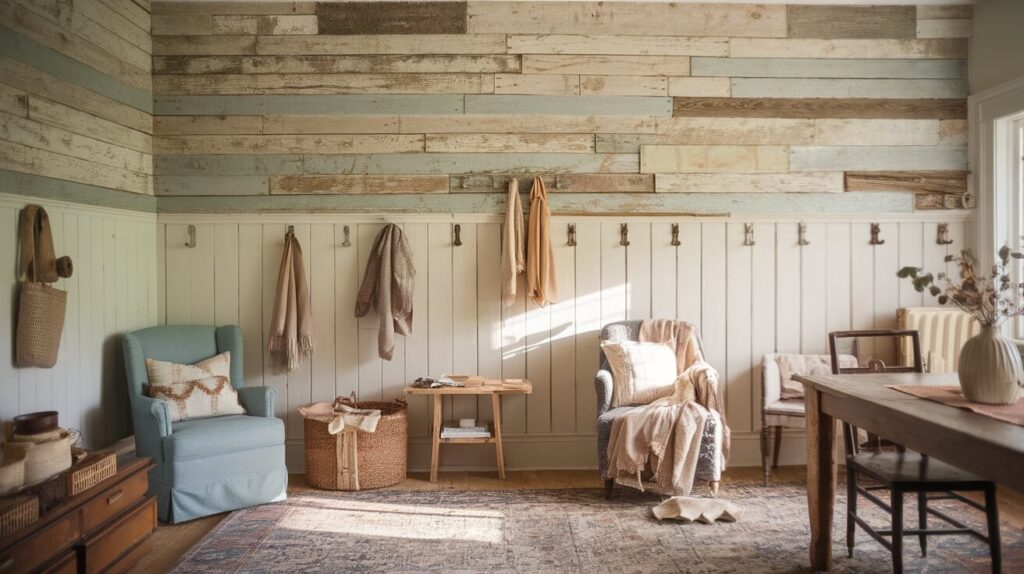
Weathered and distressed wood brings character and story to a space. This style feels lived-in and comfortable, perfect for creating a cozy, welcoming atmosphere. The imperfections in the wood become features rather than flaws.
When I renovated an old farmhouse, we salvaged barn wood for the entryway shiplap. Its authentic marks and scratches tell a story that new materials simply can’t replicate. For those without access to reclaimed wood, new boards can be artfully distressed to achieve a similar effect.
How to incorporate it effectively:
- Source reclaimed wood when possible for authentic character
- For new wood, create distressing using chains, hammers, screws, and sandpaper
- Apply white or light-colored paint, then sand parts away to reveal wood underneath
- Leave some areas more heavily distressed than others for a natural look
- Install in kitchen eating areas, mudrooms, or casual living spaces
- Add vintage hooks, knobs, or hardware to enhance the timeworn aesthetic
- Pair with soft textiles, antique items, and casual furniture pieces
- Balance with some modern elements to keep the look fresh rather than theme-heavy
6. Vertical Shiplap with Chair Rail Cap

Adding a chair rail cap to your vertical shiplap half wall creates a finished look that bridges modern and traditional styles. This detail transforms a simple wall treatment into an architectural feature that feels intentional and polished.
I find this approach particularly effective in homes with other traditional moldings. The chair rail cap ties the shiplap into the home’s existing trim work, creating a cohesive design language throughout the space. The vertical boards feel fresh and modern, while the cap adds a classic touch.
How to incorporate it effectively:
- Install vertical boards first, stopping at your desired height (typically 32-36 inches)
- Select a chair rail profile that complements other trim in your home
- Mount the chair rail directly on top of the shiplap boards
- Paint the rail and shiplap the same color for a seamless look, or contrast for definition
- Consider adding a small shelf detail on top of the rail for displaying small items
- This style works particularly well in dining rooms, hallways, and living areas
- Balance with both modern and traditional furnishings for an eclectic, transitional look
- For extra detail, add a small base trim at the bottom of the shiplap section
7. Soft Pastel Accent for Kids’ Spaces
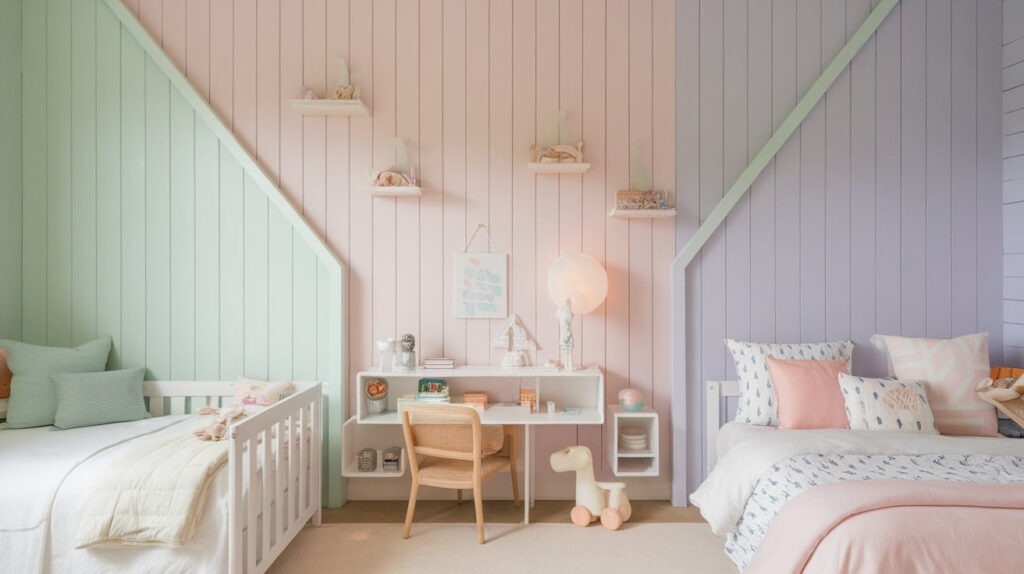
Gentle colors bring a soothing yet playful quality to children’s rooms. Vertical shiplap in soft pastels creates a sweet backdrop that can grow with your child from infancy through the early school years. The texture adds interest while the soft color keeps the space feeling calm.
I painted my daughter’s half wall a soft mint green when she was two. Now at nine years old, the color still works perfectly with her changing interests and decor. The vertical lines add a sense of height to the room while the color adds personality without being overwhelming.
How to incorporate it effectively:
- Choose washable paint in soft colors like pale blue, mint green, blush pink, or lavender
- Install at crib or bed height (approximately 36-42 inches)
- Use a semi-gloss finish for easy cleaning of fingerprints and marks
- Pair with simple white furniture that won’t compete with the color
- Add toys, art, and accessories in complementary colors that can be easily changed
- Consider installing in nurseries, children’s bedrooms, or playrooms
- Balance the sweet color with some more mature elements to create a space that grows with your child
- For extra durability in high-touch areas, add a clear protective topcoat
8. Accent Wall for a Reading Nook
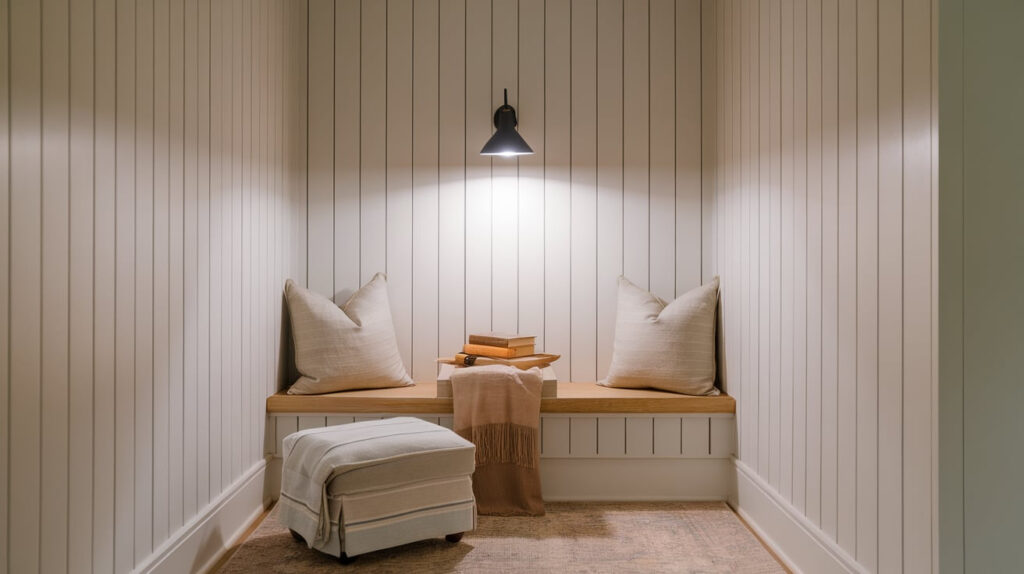
A reading nook with vertical shiplap creates a designated space for relaxation and reflection. The textured wall helps define the area as separate from the rest of the room without requiring additional walls or construction. It’s a simple way to create a special spot that feels intentional.
In my own home, I created a reading corner in our living room using vertical shiplap painted in a slightly darker shade than the main walls. The effect is subtle but effective-everyone naturally gravitates to that cozy spot with a book.
How to incorporate it effectively:
- Create a half wall of vertical shiplap in a quiet corner of a room
- Keep the height at about 4 feet to define the space without closing it off
- Paint in a color slightly different from your main walls-either darker or in a complementary hue
- Add a small reading lamp that attaches to the wall at the top edge of the shiplap
- Place a comfortable chair or small loveseat against the wall
- Add a small side table or floating shelf for books and beverages
- Consider adding soft textiles like throw pillows and a small area rug to further define the space
- This works well in living rooms, bedrooms, or unused corners of larger spaces
9. Top-Half Wallpaper, Bottom-Half Shiplap
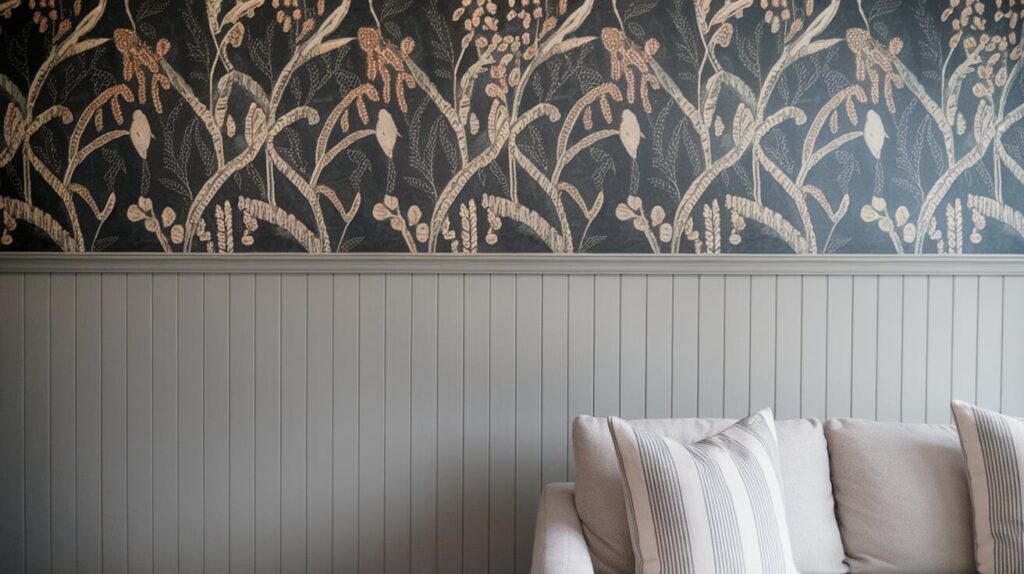
This combination creates a perfect balance between pattern and texture. The solid shiplap grounds the space while the wallpaper adds personality and visual interest. It’s a modern take on traditional wainscoting that works in both contemporary and traditional homes.
When I tried this in a client’s powder room, the effect was stunning. The vertical shiplap provided durability in a high-traffic area while the botanical wallpaper above added personality and style. The combination felt fresh but timeless.
How to incorporate it effectively:
- Install vertical shiplap on the bottom half of your wall (about 3-4 feet high)
- Cap with a simple trim piece to create a clean transition
- Apply wallpaper to the upper portion, making sure patterns align properly
- Choose wallpaper and shiplap colors that complement each other
- For subtle looks, match the shiplap color to a background color in the wallpaper
- For bold looks, create intentional contrast between the two elements
- This works beautifully in dining rooms, powder rooms, home offices, or bedrooms
- Balance with simple furniture that won’t compete with the wall treatment
- Consider scale carefully-if using a busy wallpaper pattern, keep the shiplap simple
10. Farmhouse Entry with Antique Hooks
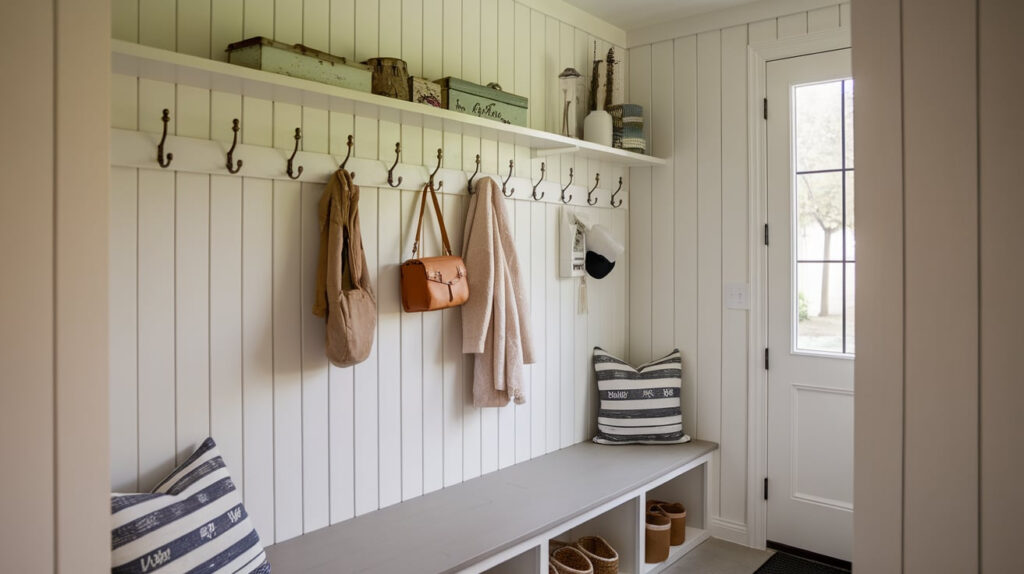
Combining vertical shiplap with vintage hooks creates an entryway that’s both practical and stylish. The durable shiplap surface stands up to daily wear and tear while the hooks provide essential storage for coats, bags, and hats.
In my busy household, this combination has proven invaluable. The vertical boards hide scuffs and bumps better than plain drywall, and the antique hooks add character while serving an important function. It’s a perfect example of form meeting function.
How to incorporate it effectively:
- Install vertical shiplap in your entryway at about 5 feet high
- Add a simple 1×4 board or narrow shelf across the top
- Mount vintage or antique hooks spaced 8-12 inches apart
- Consider variability in hook heights for both adults and children
- Paint in a durable finish that can withstand frequent touching and cleaning
- Classic white works well, but don’t be afraid to try muted colors that complement your home
- Add a small bench below if space permits
- This works perfectly in entryways, mudrooms, or back hallways
- Consider adding a small shelf above the hooks for seasonal decor or additional storage
11. Bathroom Backdrop Behind Freestanding Tub
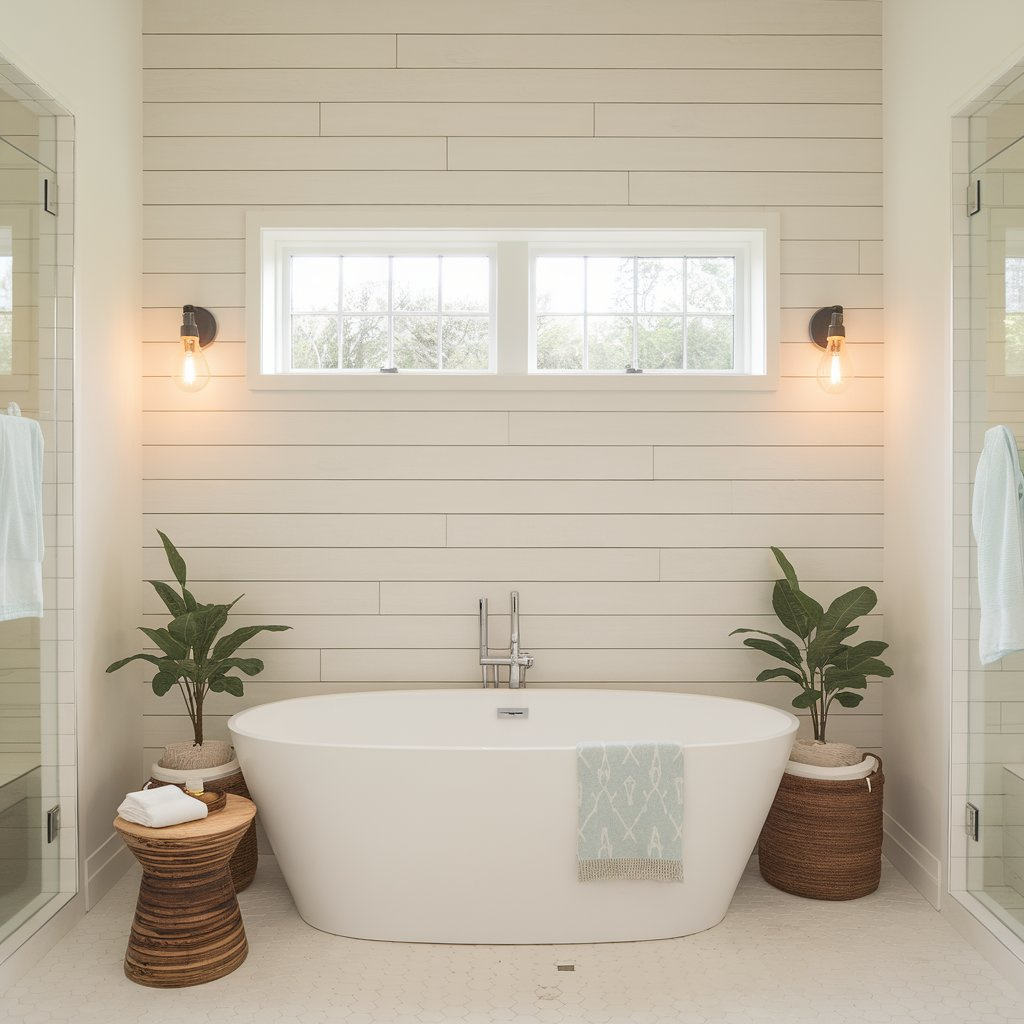
Vertical shiplap creates a striking focal point behind a freestanding tub. The texture contrasts beautifully with the smooth surfaces of bathroom fixtures and tile. This application adds warmth and character to what might otherwise be a cold, clinical space.
When I renovated my master bathroom, adding vertical shiplap behind the tub transformed the space from basic to spa-like. The wooden texture, even when painted, adds an organic element that softens the hard surfaces typical in bathrooms.
How to incorporate it effectively:
- Install vertical shiplap on the wall behind your freestanding tub
- Extend it to about 4-5 feet high, or to window height if applicable
- Seal thoroughly with water-resistant polyurethane (apply at least 3 coats)
- Consider marine-grade plywood or water-resistant MDF for maximum durability
- Leave a small gap (1/4 inch) between the tub and the bottom of your shiplap
- White creates a clean, spa-like feeling, but soft blues and greens can also work well
- Add soft lighting, such as sconces, on either side of the shiplap wall
- Pair with natural elements like wooden bath accessories or plants that thrive in humid environments
- For added protection, consider installing a glass panel between the tub and the shiplap if you have a shower attachment
12. Vertical Shiplap with Built-in Bench or Ledge
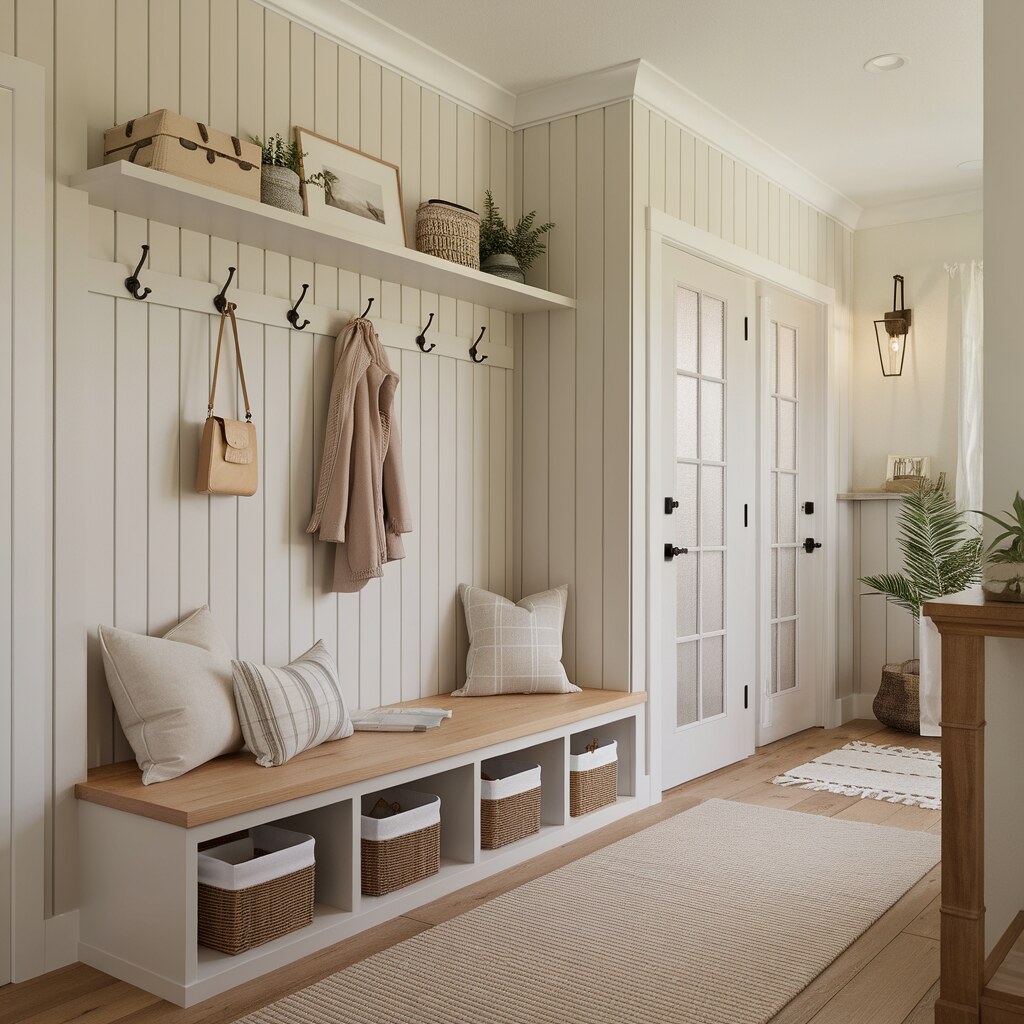
Adding functional elements to your shiplap wall multiplies its value in your home. A built-in bench or ledge creates usable space while the shiplap backdrop adds visual interest. This combination is particularly useful in smaller homes where every inch counts.
My entryway bench with vertical shiplap backing has become the most useful feature in our front hall. It provides seating for putting on shoes, storage underneath for seasonal items, and hooks above for everyday coats and bags. The vertical shiplap ties it all together visually.
How to incorporate it effectively:
- Install vertical shiplap first, extending to your desired height
- Build a simple bench frame that attaches securely to the wall and floor
- For a bench, aim for 16-18 inches high and 12-16 inches deep
- For a slim ledge, 3-4 inches deep works well for small decorative items
- Add cushions to benches for comfort or leave wood exposed for a cleaner look
- Consider storage underneath benches either open cubbies or hinged lids
- Paint the shiplap and bench in complementary colors or match them for a built-in look
- This works perfectly in entryways, mudrooms, breakfast nooks, or window seats
- Add pillows, baskets, and other accessories to make the space both functional and attractive
- For extra durability in seating areas, use a heavy-duty polyurethane finish on both the bench and the shiplap
How to Install a Vertical Shiplap Half Wall
I’ve installed several vertical shiplap walls and with the right prep, you can finish this project in a weekend.
Tools & Materials You’ll Need
- Boards – Pine tongue and groove, pre-made shiplap, or plywood
- Measuring tools – Tape, pencil, level, stud finder
- Cutting & fastening – Saw, nail gun with 1.5-inch brads, wood glue
- Finishing supplies – Spacers, caulk, wood filler, sandpaper, paint, trim
Step-by-Step Installation
- Plan carefully – Measure twice, mark wall height (36-48″ works best), locate and mark all studs
- Install boards – Start in the most visible corner with a perfectly level first board, secure to studs, use spacers between boards
- Finish the surface – Fill nail holes, sand smooth (120 then 220 grit), caulk edges, prime and paint, add top trim
Pro Tips
- Use actual spacers for consistent gaps
- Check for level frequently
- Seal thoroughly in moisture-prone areas
- Choose semi-gloss or satin paint for easy cleaning
- Don’t rush – mistakes are hard to fix later
FAQs
How much does vertical shiplap cost?
Materials run $1-5 per square foot depending on wood quality. Budget $150-300 for an average wall plus tools.
Can I install over textured walls?
Yes, but consider adding thin plywood first for a smooth base. Otherwise, texture shows through gaps.
How long does installation take?
First-timers: one weekend. Experienced DIYers: about 4-6 hours for an average-sized wall.
What’s the difference between shiplap and board-and-batten?
Shiplap boards connect side-by-side. Board-and-batten has wide boards with narrow strips covering seams.
Is vertical or horizontal shiplap better?
Vertical makes ceilings feel higher. Horizontal makes rooms feel wider. Both work well-choose based on your space needs.
What rooms work best for half walls?
Entryways, dining rooms, bathrooms, and hallways benefit most from the durability and visual interest.

